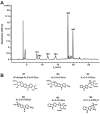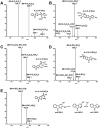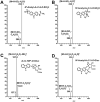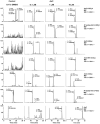Metabolism of the Tobacco Carcinogen 2-Amino-9H-pyrido[2,3-b]indole (AαC) in Primary Human Hepatocytes
- PMID: 27976871
- PMCID: PMC5439433
- DOI: 10.1021/acs.chemrestox.6b00394
Metabolism of the Tobacco Carcinogen 2-Amino-9H-pyrido[2,3-b]indole (AαC) in Primary Human Hepatocytes
Abstract
2-Amino-9H-pyrido[2,3-b]indole (AαC) is the most abundant carcinogenic heterocyclic aromatic amine (HAA) formed in mainstream tobacco smoke. AαC is a liver carcinogen in rodents, but its carcinogenic potential in humans is not known. To obtain a better understanding of the genotoxicity of AαC in humans, we have investigated its metabolism and its ability to form DNA adducts in human hepatocytes. Primary human hepatocytes were treated with AαC at doses ranging from 0.1-50 μM, and the metabolites were characterized by ultra-performance LC/ion trap multistage mass spectrometry (UPLC/MSn). Six major metabolites were identified: a ring-oxidized doubly conjugated metabolite, N2-acetyl-2-amino-9H-pyrido[2,3-b]indole-6-yl-oxo-(β-d-glucuronic acid) (N2-acetyl-AαC-6-O-Gluc); two ring-oxidized glucuronide (Gluc) conjugates: 2-amino-9H-pyrido[2,3-b]indol-3-yl-oxo-(β-d-glucuronic acid) (AαC-3-O-Gluc) and 2-amino-9H-pyrido[2,3-b]indol-6-yl-oxo-(β-d-glucuronic acid) (AαC-6-O-Gluc); two sulfate conjugates, 2-amino-9H-pyrido[2,3-b]indol-3-yl sulfate (AαC-3-O-SO3H) and 2-amino-9H-pyrido[2,3-b]indol-6-yl sulfate (AαC-6-O-SO3H); and the Gluc conjugate, N2-(β-d-glucosidurony1)-2-amino-9H-pyrido[2,3-b]indole (AαC-N2-Gluc). In addition, four minor metabolites were identified: N2-acetyl-9H-pyrido[2,3-b]indol-3-yl sulfate (N2-acetyl-AαC-3-O-SO3H), N2-acetyl-9H-pyrido[2,3-b]indol-6-yl sulfate (N2-acetyl-AαC-6-O-SO3H), N2-acetyl-2-amino-9H-pyrido[2,3-b]indol-3-yl-oxo-(β-d-glucuronic acid) (N2-acetyl-AαC-3-O-Gluc), and O-(β-d-glucosidurony1)-2-hydroxyamino-9H-pyrido[2,3-b]indole (AαC-HN2-O-Gluc). The latter metabolite, AαC-HN2-O-Gluc is a reactive intermediate that binds to DNA to form the covalent adduct N-(2'-deoxyguanosin-8-yl)-2-amino-9H-pyrido[2,3-b]indole (dG-C8-AαC). Preincubation of hepatocytes with furafylline, a selective mechanism-based inhibitor of P450 1A2, resulted in a strong decrease in the formation of AαC-HN2-O-Gluc and a concomitant decrease in DNA adduct formation. Our findings describe the major pathways of metabolism of AαC in primary human hepatocytes and reveal the importance of N-acetylation and glucuronidation in metabolism of AαC. P450 1A2 is a major isoform involved in the bioactivation of AαC to form the reactive AαC-HN2-O-Gluc conjugate and AαC-DNA adducts.
Figures








Similar articles
-
UDP-glucuronosyltransferase-mediated metabolic activation of the tobacco carcinogen 2-amino-9H-pyrido[2,3-b]indole.J Biol Chem. 2012 Apr 27;287(18):14960-72. doi: 10.1074/jbc.M111.320093. Epub 2012 Mar 5. J Biol Chem. 2012. PMID: 22393056 Free PMC article.
-
Bioactivation of Heterocyclic Aromatic Amines by UDP Glucuronosyltransferases.Chem Res Toxicol. 2016 May 16;29(5):879-91. doi: 10.1021/acs.chemrestox.6b00046. Epub 2016 Apr 18. Chem Res Toxicol. 2016. PMID: 27032077 Free PMC article.
-
2-Amino-9H-pyrido[2,3-b]indole (AαC) Adducts and Thiol Oxidation of Serum Albumin as Potential Biomarkers of Tobacco Smoke.J Biol Chem. 2015 Jun 26;290(26):16304-18. doi: 10.1074/jbc.M115.646539. Epub 2015 May 7. J Biol Chem. 2015. PMID: 25953894 Free PMC article.
-
Two food-borne heterocyclic amines: metabolism and DNA adduct formation of amino-alpha-carbolines.Mol Nutr Food Res. 2005 Mar;49(3):263-73. doi: 10.1002/mnfr.200400061. Mol Nutr Food Res. 2005. PMID: 15704238 Review.
-
Mutagens formed from beta-carbolines with aromatic amines.J Chromatogr B Analyt Technol Biomed Life Sci. 2004 Mar 25;802(1):135-41. doi: 10.1016/j.jchromb.2003.10.041. J Chromatogr B Analyt Technol Biomed Life Sci. 2004. PMID: 15036005 Review.
Cited by
-
Quantification of Hemoglobin and White Blood Cell DNA Adducts of the Tobacco Carcinogens 2-Amino-9H-pyrido[2,3-b]indole and 4-Aminobiphenyl Formed in Humans by Nanoflow Liquid Chromatography/Ion Trap Multistage Mass Spectrometry.Chem Res Toxicol. 2017 Jun 19;30(6):1333-1343. doi: 10.1021/acs.chemrestox.7b00072. Epub 2017 May 25. Chem Res Toxicol. 2017. PMID: 28493705 Free PMC article.
-
Constructing xenobiotic maps of metabolism to predict enzymes catalyzing metabolites capable of binding to DNA.BMC Bioinformatics. 2021 Sep 21;22(1):450. doi: 10.1186/s12859-021-04363-6. BMC Bioinformatics. 2021. PMID: 34548010 Free PMC article.
-
Evaluation of Tobacco Smoke and Diet as Sources of Exposure to Two Heterocyclic Aromatic Amines for the U.S. Population: NHANES 2013-2014.Cancer Epidemiol Biomarkers Prev. 2020 Jan;29(1):103-111. doi: 10.1158/1055-9965.EPI-19-0169. Epub 2019 Oct 1. Cancer Epidemiol Biomarkers Prev. 2020. PMID: 31575556 Free PMC article.
-
N-acetyltransferase 2 acetylator genotype-dependent N-acetylation and toxicity of the arylamine carcinogen β-naphthylamine in cryopreserved human hepatocytes.Arch Toxicol. 2022 Dec;96(12):3257-3263. doi: 10.1007/s00204-022-03381-4. Epub 2022 Sep 16. Arch Toxicol. 2022. PMID: 36112171 Free PMC article.
-
Bioactivation of the tobacco carcinogens 4-aminobiphenyl (4-ABP) and 2-amino-9H-pyrido[2,3-b]indole (AαC) in human bladder RT4 cells.Arch Toxicol. 2019 Jul;93(7):1893-1902. doi: 10.1007/s00204-019-02486-7. Epub 2019 Jun 15. Arch Toxicol. 2019. PMID: 31203411 Free PMC article.
References
-
- Giovannucci E. An updated review of the epidemiological evidence that cigarette smoking increases risk of colorectal cancer. Cancer Epidemiol Biomarkers Prev. 2001;10:725–731. - PubMed
-
- Hoffmann D, Hoffmann I, El-Bayoumy K. The less harmful cigarette: a controversial issue. a tribute to Ernst L. Wynder. Chem Res Toxicol. 2001;14:767–790. - PubMed
Publication types
MeSH terms
Substances
Grants and funding
LinkOut - more resources
Full Text Sources
Other Literature Sources

